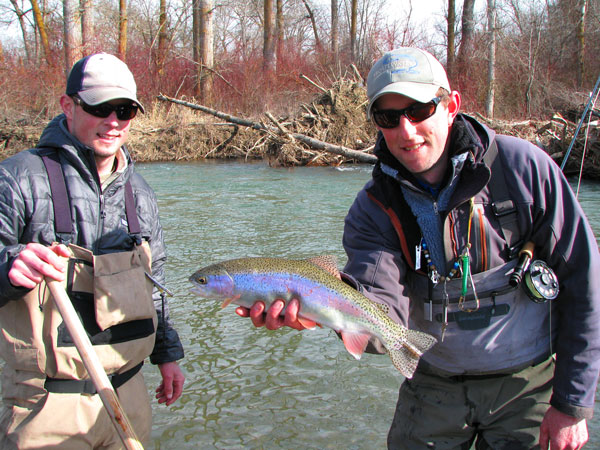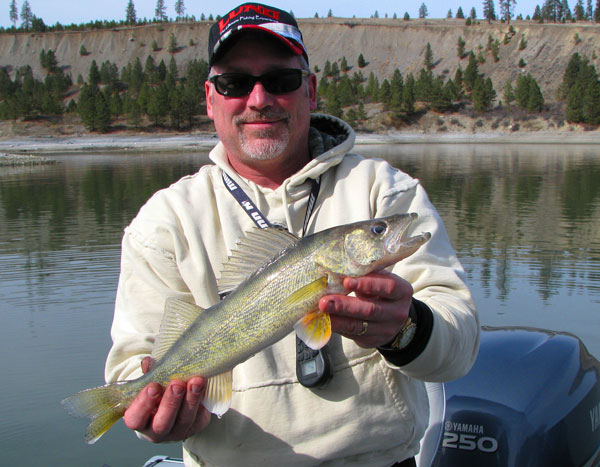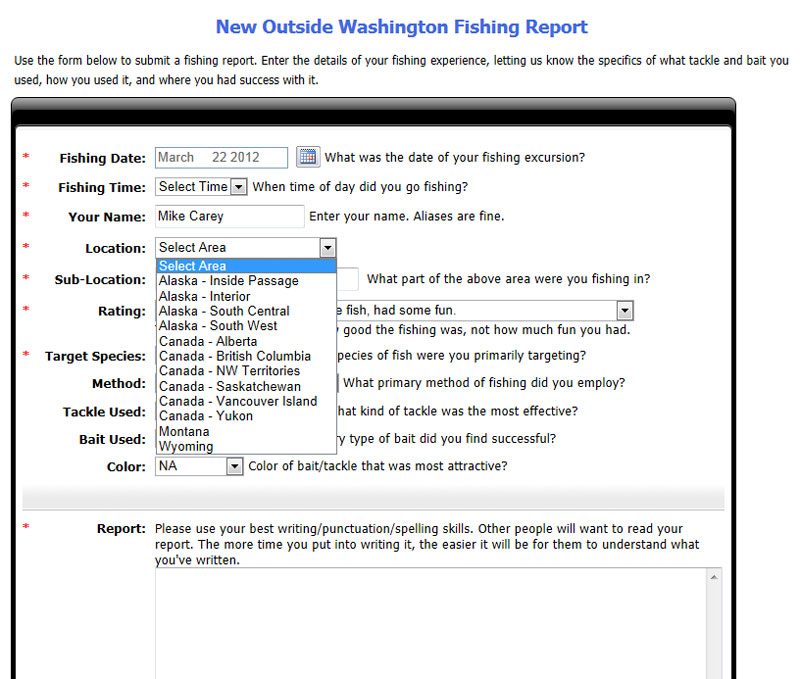Search
Latest Articles
Central Washington Walleye and Steelheading!
by Dave Graybill, March 19, 2012
We were breaking a thin layer of ice as we left the slip in the marina at Two Rivers. Rick Rovegno, of Big Wally’s Guide Service, assured me that the ice layer wasn’t as thick as the day before and we could expect temperatures in the 50s. He and his son Hayden had a good trip the day before and although I thought the conditions were more like winter than spring, he laughed and said things were shaping up for a great day of walleye fishing on the main lake and up the Spokane River.
If the name Big Wally’s sounds familiar, it is for good reason. Gordon and Marge Steinmetz had owned and operated the Big Wally’s gas station, store and restaurant in Coulee City for years. Gordon was a tournament walleye angler and guide. He founded the Big Wally’s Spring Classic Walleye Tournament that takes place in May every year on Banks Lake. The store was sold a couple of years ago and Gordon retired from the guide business. He passed the guide operation on to his nephew Rick Rovegno to continue the tradition of offering an excellent guide service on the many walleye rich waters of Central Washington. Rovegno has been a tournament walleye angler for over ten years and has now been guiding for over five. He and I had been talking on the phone since last fall. At the sports show in Puyallup we set this date for the trip.
We didn’t have to run far to find one of his favorite spots to catch walleye this time of year. Running out of the mouth of the Spokane River, where the Two Rivers Marina sets, there is a ridge that he likes to check for fish. This time of year the fish are deep, and we were into walleye right away, at close to 50 feet deep. Rovegno set us up with jigs. These were 3/8th ounce glo jigs in chanteuse with a red eye. The jigs that worked best had no skirt, and he would thread a piece of nightcrawler on the hook, leaving just an inch or two trailing. He had a nifty tool to zap the jigs with light to make them ultra bright. It is made by Rapala and looks like a hard case for eye glasses. Inside are a series of LED lights. He closed the lid around the rig and hit a button for a few seconds and the result is a jig that will really stand out in the darkness at 50 feet deep.
We would either “dead stick” these jigs, leaving the rod in the holder and let them drag across the bottom, or would give them just a slight action with the rod in our hand. This time of year with the chilly water temperatures a walleye isn’t likely to chase down an active bait. A smaller bait, presented slowly is more effective. Rovegno tried to keep our speed close to just a half mile an hour.
This ridge produced some fish for us, but there was a spot up the Spokane River that had really paid off for him and his son the day before. We reeled up and ran up under the bridge over the Spokane River and maybe about a half mile up to where he had found hungry walleye. We used the same tactics, but found fish anywhere from about 35 to 45 feet in this area. Looking at the exposed shoreline I could see that there were a lot of gentle humps carved out by the river current and the walleye were moving around this structure. The same jigs worked just fine here, too, and we had some good flurries of action where we would put two or three fish in the boat very quickly and then hunt around for another group of fish looking for lunch.
We did run down lake about four miles to try a flat. The wind had come up on the main lake and Rovegno put out a wind sock to try to keep our drift within that five mile per hour speed. I missed a good fish and Hayden landed one in this area, but we soon decided to head back up to the ridge we first fished, and get out of the wind. It was a good choice. Hayden brought a nice fish on board soon after we arrived, and when Rick and I landed a double we decided to call it a day. We had left the marina at about 9 a.m. and quit at 2:30. There were 17 walleye in the live well and they ranged from 12 to 17 inches. Not a bad day of fishing for walleye anytime of year.
Rovegno sure knew where to find fish on Lake Roosevelt and I would suggest that if you would like to learn more about the fishing here or even book a trip with Rick to give him a call or shoot him an e-mail. His phone number is 509-954-4570, and his e-mail address is dikntam@comcast.net.
Steelheading - back in business!
The big news is that the Wenatchee, Icicle and Methow rivers have reopened to steelhead fishing. Anglers should expect very good fishing on these streams. The season is set to run through the end of March, but could end early, depending on the number of wild fish caught and released. I had some experience with steelhead fishing this past week. I caught fish on the Okanogan River, and of all places the Yakima River.
Jerrod Gibbons, of Okanogan Valley Guide Service, and I had been trying to get out on the Okanogan River after the ice came off. Although the forecast that day was for some wet weather we decided to go for it. His father Tom joined us and we put the boat in at the rough launch above the mouth and headed up stream. It took us no time at all to get to the Trestle Hole, about a five mile run in the jet sled. Navigating the shallow Okanogan in the sled was easy. We worked our bobbers and jigs through the hole without even a sniff, so we kept making our way up the river
Before I knew it we had run up the Okanogan as far as what is known as Rattlesnake, which is a good distance from the launch. Rattlesnake is positioned below a bend in the river and there are a few boulders scattered off the shore that hold steelhead. We started at the top of the hole when it really started snowing seriously. We had a couple of suspicious looking bumps, but nothing that would take the bobber down.
Gibbons backed the boat down through the hole and he hooked but lost a fish in the lower section. I had been allowing my bobber to slide way down below the boat, and when it was at the extreme end of the drift my bobber disappeared. I don’t know how but I set the hook and worked a small hatchery hen up to the net. We made a couple more casts but decided that the weather had put the fish off the bite, and it was snowing fiercely by now.
The run back to the launch was brutal. We took turns running the boat. Gibbons would go as long as he could before he just couldn’t see anymore due the stinging snow in his eyes. I would take over and run until he couldn’t see my eyes through my glasses, as they were coated with snow and ice. We finally made it back to launch and celebrated at least not getting skunked in such adverse conditions. Admitting that we were sure some crazy steelhead anglers, we hopped into our warming trucks and headed home.
The next day I had a trip scheduled with Johnny Boitano, of the Troutwater Fly Shop and Guide Service in Ellensburg. I was reluctant as the forecast again was for wet weather and even worse, high winds. Boitano assured me that there were areas that we could avoid the wind. He and his brother Jason and I jumped into one drift boat and Ted Truglio, TJ and Devon Zanoli hopped into another to join us on the float.
To our surprise the day had broken mostly clear and sunny, and the “W” (you don’t say wind out loud), wasn’t a factor at all. Johnny Boitano took the oars while Jason took the position in the back end of the boat. These guys knew every pocket and eddy that held fish, and while I missed fish after fish, Jason landed a bunch of trout. The first fish he landed was a cutthroat of at least 15 inches and he caught a couple of big whitefish and rainbow that ranged in size from 13 to 16 inches.
Johnny was busy. When he wasn’t rowing he was re-rigging my set up. He changed depths constantly and just as often replaced the flies. He experimented with a variety of Skwala Stones and droppers that varied from small nymphs to San Juan Worms of their own design. We caught fish on the stones, including a new one that Jason had created, and the San Juan Worms really worked well, too.
I had a Skwala Stone with a San Juan Worm in my line, below a large indicator when we started down a long straight run. We hadn’t gone very far down this stretch when my indicator shot out of sight. Johnny and Jason were yelling and I managed to set the hook this time. It only took a couple of seconds to realize that I had hooked a steelhead! I was using a 5 weight rod with a 5-pound tippet and this fish was having its way with me. While my knees were knocking Boitano first anchored and then pulled up and chased the fish further down stream. Somehow I managed to get the fish close enough to the boat so Johnny was able to slide the knotless net under it. We all celebrated after releasing the wild fish that had made its way over Rosa Dam into this area of the Yakima.
We continued down stream, pushing the boat over a log jam at one point and caught many more rainbow, even one that gave Jason a real tussle and turned out to be an 18-incher. This day was just further proof that the early spring fishing on the Yakima can be spectacular. It made for a great TV Show that you all can watch in a couple of weeks.
My next stop will be in the Northport area of the Columbia, near the Canadian Border. Here I will be fishing for walleye and big rainbow and cutthroat. Man, I am having some great fishing and it’s only going to get better!
By Dave Graybill
fishingmagician.com


